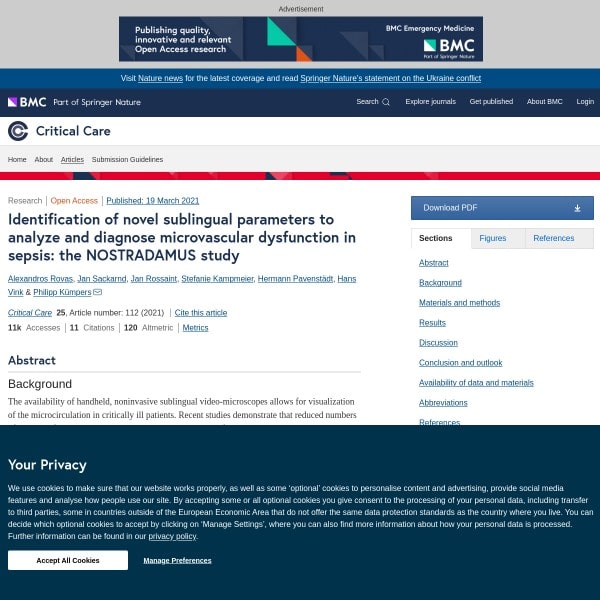Abstract
Background
Microvascular dysfunction plays a central role in organ dysfunction during septic shock. Endothelial glycocalyx (eGC) damage could contribute to impaired microcirculation. The aim was to assess whether several eGC-damaged biomarkers are associated with microvascular dysfunction in resuscitated septic shock patients.
Methods
This cross-sectional study included resuscitated septic shock patients (N = 31), and a group of healthy individuals (N = 20). The eGC damage biomarkers measured were syndecan-1 (SDC-1), soluble CD44 (CD44s), hyaluronic acid (HYAL) in blood sample; sulfated glycosaminoglycans (GAGs) in urine sample; and thrombomodulin (TBML) in blood sample as biomarker of endothelial cell damage. Microcirculation was assessed through sublingual videocapillaroscopy using the GlycoCheck™, which estimated the perfused vascular density (PVD); the perfused boundary region (PBR), an inverse parameter of the eGC thickness; and the microvascular health score (MVHS). We defined a low MVHS (<50th percentile in septic patients) as a surrogate for more impaired microvascular function.
Results
The SDC-1, CD44s, TBML and GAGs levels were correlated with impaired microvascular parameters (PVD of vessels with diameter < 10 μm, MVHS and flow-adjusted PBR); p < 0.05 for all comparisons, except for GAGs and flow-adjusted PBR. The SDC-1 [78 ng/mL (interquartile range (IQR) 45–336) vs. 48 ng/mL (IQR 9–85); p = 0.052], CD44s [796ρg/mL (IQR 512–1995) vs. 526ρg/mL (IQR 287–750); p = 0.036], TBML [734ρg/mL (IQR 237–2396) vs. 95ρg/mL (IQR 63–475); p = 0.012] and GAGs levels [0.42 ρg/mg (IQR 0.04–1.40) vs. 0.07 ρg/mg (IQR 0.02–0.20); p = 0.024]; were higher in septic patients with more impaired sublingual microvascular function (low MVHS vs. high MVHS).
Conclusion
SDC-1, CD44s, TBML and GAGs levels were associated with impaired microvascular function in resuscitated septic shock patients.




